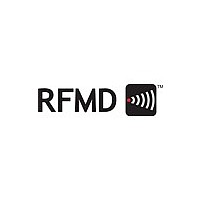RF2411TR7 RFMD, RF2411TR7 Datasheet - Page 2

RF2411TR7
Manufacturer Part Number
RF2411TR7
Description
IC AMP/MIXER LOW-NOISE 14-SOIC
Manufacturer
RFMD
Datasheet
1.RF2411TR7.pdf
(4 pages)
Specifications of RF2411TR7
Rf Type
UHF
Frequency
500MHz ~ 1.9GHz
Number Of Mixers
1
Gain
25dB
Noise Figure
3.4dB
Current - Supply
8.5mA
Voltage - Supply
3 V ~ 6.5 V
Package / Case
14-SOIC (0.154", 3.90mm Width)
Lead Free Status / RoHS Status
Lead free / RoHS Compliant
Secondary Attributes
-
Available stocks
Company
Part Number
Manufacturer
Quantity
Price
Company:
Part Number:
RF2411TR7
Manufacturer:
RFMD
Quantity:
5 000
15
The excellent broadband impedance match insures
optimum duplexer and image filter performance. In
addition, the wideband gain, noise and isolation char-
acteristics guarantee simple application to many UHF
receiver systems.
The RF2411 mixer is a double-balanced “Gilbert”
type with differential IF output taken as open collectors
for flexible IF interface. The RF input is typically
matched to 50Ω system impedance using a single
external series inductor, in this case 27nH, to cancel
capacitive reactance. The LO input is internally
matched over the full frequency range. LO input return
loss increases from 11dB at 1MHz to 22dB at
1500MHz.
The doubly-balanced mixer delivers greater than 30dB
LO input to mixer RF input isolation. LO input to IF out-
put isolation is typically greater than 30dB over the
1MHz to 1500MHz range for differential IF interface.
Mixer RF to IF isolation is typically greater than 25dB
over the 400MHz to 1500MHz range.
Mixer conversion gain is dependent upon details of the
IF interface. Power gain is directly dependent upon
interface impedance. A 1000Ω interface impedance
will result in 3dB more conversion gain than a 500Ω
interface impedance, for example. Also, a differential
interface will result in 6dB more gain than a single-
ended interface at the same impedance level.
A differential interface can be through a balun trans-
former or directly to a differential SAW IF filter. Alter-
nately, one collector may be tied directly to V
output taken single-ended from the remaining output.
In either case, maximum performance in typical appli-
cation is obtained connecting the mixer collector(s) to
V
capacitance, including circuit board trace and filter
capacitance, so that the interface is entirely resistive at
the IF frequency. The output capacitance of the mixer
itself is less than 1pF per collector.
Figure 4 shows the dependence of mixer noise figure,
gain, and IIP3 on power supply voltage at 880MHz RF
and 965MHz LO (85MHz 1000Ω differential IF inter-
15-122
CC
TA0026
through inductors resonant with the IF circuit
Copyright 1997-2002 RF Micro Devices, Inc.
CC
and
face). Gain can be seen to decrease from 12.8dB to
9.6dB as V
decreases from +2.8dBm to -10.3dBm, and SSB noise
figure decreases from 12.85dB to 8.22dB over the
same voltage range. This characteristic indicates best
noise figure but poorer IIP3 and gain (and thus higher
noise contribution from following components) at lower
power supply voltage compared with V
Figure 5 shows the dependence of mixer gain, noise
figure, and IIP3 on LO input power (V
F
F
gain and noise figure are only weakly dependent upon
LO drive between -6dBm and +5dBm. IIP3 is maxi-
mum (+3.5dBm) at lowest LO drive, decreasing to
2.9dBm at -3dBm and more sharply to -3dBm at
+5dBm LO drive. This characteristic indicates optimum
Figure 4: Mixer Gain, Noise Figure, and IIP3 vs.
Supply Voltage
RF
IF
Figure 5: Mixer Gain, Noise Figure, and IIP3
vs. LO Power
=85MHz, 1000Ω differential interface). Conversion
=880MHz
-10
-15
15
10
-5
5
0
2.5
25
20
15
10
-5
5
0
-15 -14 -13 -12 -11
CC
3
is reduced from 5V to 2.5V. IIP3
-10
and
-9
Frf = 880 &881 MHz, Flo = 965 MHz, Vcc = 5V
-8
3.5
RF2411 Mixer Performance vs. LO Power
RF2411 Mixer Performance
Flo = 965 MHz @ -3 dBm
-7
Vcc (Volts)
Frf = 880 &881 MHz
LO Power (dBm)
881MHz,
-6
-5
-4
4
-3
-2
Conversion Gain
SSB NF
IIP3
-1
CC
4.5
0
F
=5V.
LO
Conversion Gain
SSB NF
IIP3
1
=965MHz,
2
CC
3
=5.0V,
4
5
5












